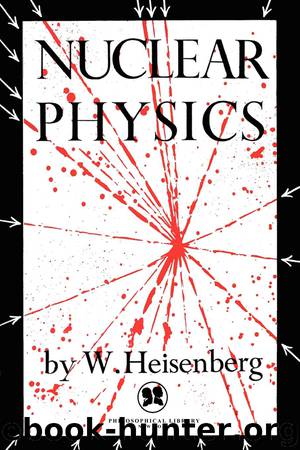Nuclear Physics by W Heisenberg

Author:W Heisenberg [Heisenberg, W]
Language: eng
Format: epub
ISBN: 9781504022873
Publisher: Philosophical Library
Published: 2012-04-03T04:00:00+00:00
Figure 17.—Ion of hydrogen molecule.
Figure 17A.—Scattering of neutrons in hydrogen.
The situation is, however, not quite so simple as we have made it appear. If the analogy of nuclear and electric forces were as we have been supposing, we would be in a position to determine the frequency of the occurrence of beta decay in a manner similar to that employed to determine the frequency of the occurrence of the emission of a photon in the extranuclear structure of the atom. When an extranuclear atomic structure is in an excited state, there exists in it at any given moment a certain probability of the emission of a light ray. By ‘certain probability’ we mean the following: In the wave aspect, the continuous movement of electrons causes a wave radiation to issue forth. In the particle aspect, there exists at any given moment a certain probability of the emission of a photon. These two views of the situation are linked to each other by the fact that the probability of radiation is given by the intensity of the emitted wave. The stronger is the wave, the greater is the probability of radiation, and the shorter-lived is the excited state. The duration of the excited state depends, therefore, on the amplitude of the vibration of the electrons.
The lifetime of a beta-unstable nucleus thus depends on the intensity of the wave radiation issuing forth from it. But if we carry out this computation on the ground of the considerations outlined above, we arrive at lifetimes much shorter than those actually observed. There still exists a discrepancy at this point, and this realization led the Japanese scientist Yukawa to a somewhat modified theory.
Yukawa assumes that between the nuclear field and the electrons, positrons and neutrinos there is still another species of particle, which may be called Yukawa particle for the time being. These Yukawa particles are assumed to have a mass several hundred times that of an electron, and to be capable of disintegrating into electrons, positrons and neutrinos, directly or eventually through other decay processes. So, according to Yukawa’s theory in nuclear transmutations, such a Yukawa particle should actually be emitted. However, this does not happen, because the Yukawa particle has such a great rest mass that the energy, mc2, necessary for its formation is not available. But the Yukawa particle can break up (directly, or indirectly through other processes) into electrons and neutrinos, and this happens, in a certain sense, in the moment of its formation, so that on the whole, it is sufficient to provide the energy required for the formation of the light particles, the electron and neutrino. This theory thus regards the process of nuclear transmutation as occurring in several steps. First, the Yukawa particle is formed from the nuclear field—or more correctly, the nuclear field itself is identical with the Yukawa particle, which for lack of sufficient energy for its formation cannot manifest itself as a real particle. Instead, no sooner is it formed than it breaks up into electrons and neutrinos, which then actually leave the nucleus.
Download
This site does not store any files on its server. We only index and link to content provided by other sites. Please contact the content providers to delete copyright contents if any and email us, we'll remove relevant links or contents immediately.
| Atomic & Nuclear Physics | Particle Physics |
The Complete Stick Figure Physics Tutorials by Allen Sarah(7338)
Secrets of Antigravity Propulsion: Tesla, UFOs, and Classified Aerospace Technology by Ph.D. Paul A. Laviolette(5333)
Thing Explainer by Randall Munroe(3909)
The River of Consciousness by Oliver Sacks(3572)
The Order of Time by Carlo Rovelli(3162)
How To by Randall Munroe(3074)
A Brief History of Time by Stephen Hawking(2992)
I Live in the Future & Here's How It Works by Nick Bilton(2960)
What If?: Serious Scientific Answers to Absurd Hypothetical Questions by Randall Munroe(2667)
The Great Unknown by Marcus du Sautoy(2662)
Midnight in Chernobyl by Adam Higginbotham(2516)
Blockchain: Ultimate Step By Step Guide To Understanding Blockchain Technology, Bitcoin Creation, and the future of Money (Novice to Expert) by Keizer Söze(2467)
Networks: An Introduction by Newman Mark(2382)
The Meaning of it All by Richard Feynman(2319)
Easy Electronics by Charles Platt(2308)
The Tao of Physics by Fritjof Capra(2247)
Midnight in Chernobyl: The Untold Story of the World's Greatest Nuclear Disaster by Adam Higginbotham(2196)
When by Daniel H Pink(2098)
Introducing Relativity by Bruce Bassett(2097)
